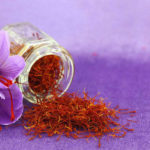1. What is Saffron Flower Stigma?
The saffron flower stigma, derived from the Crocus cartwrightianus plant native to the Mediterranean, is a highly sought-after spice. Commonly known as saffron in English, its name can be traced back to the Old French word “safran” and possibly the Latin word “safranum.” The saffron flower stigma is renowned for its unique properties and compounds, making it one of the most expensive spices worldwide.

Saffron Name
The stigma of the saffron flower, known as saffron in English, derives its name from the Old French word “safran” dating back to the 12th century. Some sources also suggest a possible origin from the Latin word “safranum.” Additionally, the Persian language has an intermediate word “safranum” referring to the stigma of the saffron flower.

Characteristics of Saffron Flower Stigma
The saffron flower stigma is sourced from the Crocus cartwrightianus plant. This perennial plant has a stem height ranging from 20-30cm and flat, straight leaves that resemble knife blades, measuring up to 40cm in length. The saffron flowers exhibit purple or yellowish-purple colors with unique veining and a honey-like fragrance. Each flower contains three deep red stigmas, measuring 25-30mm in length. Saffron flower stigma, first cultivated in Greece, holds a position as one of the most expensive spices globally. It contains over 150 volatile aromatic compounds and non-volatile compounds belonging to the carotenoid group.

2. How Many Types of Saffron Flower Stigma Are There?
Saffron flower stigma can be classified into three types based on length, cultivation conditions, and cultivation method.
Types Based on Length of Stigma
Based on length and specific characteristics, saffron flower stigma can be categorized into five common types:
Type 1: Saffron Negin
This type of saffron retains only the red part, after removing the style, and boasts the highest nutritional content. Within Saffron Negin, there are three sub-types: Premium Saffron Negin, Medium-Grade Saffron Negin, and Economical Saffron Negin. The premium and medium-grade variants are typically preferred for their superior quality.

Type 2: Saffron Sargol (also known as Saffron All-red)
This type consists of approximately two-thirds of the red-colored thread and possesses a slightly lower quality compared to Saffron Negin.
Type 3: Saffron Pushali (also known as Saffron Poushali)
Saffron Pushali contains both yellow-colored style and red-colored stigma threads, resulting in increased saffron weight. Its quality is slightly lower than that of Saffron Negin and Saffron Sargol.
Type 4: Saffron Bunch (also known as Saffron Dasteh)
Unlike previous types, Saffron Bunch retains the style (yellow color) along the whole thread (red color). This characteristic reduces its nutritional value compared to other types.
Type 5: Saffron Konj (also known as Saffron Konge)
Saffron Konj represents the base of the stigma (yellow color) and lacks the medicinal properties found in other types. It is often used for producing lower-quality Saffron Negin and Saffron Sargol.

Types Based on Cultivation Conditions
The quality of saffron can vary based on the cultivation conditions in different regions. The Mediterranean region, including countries in the Middle East and Southeast Asia, is widely regarded as the most favorable region for cultivating saffron and producing high-quality saffron flowers.

Types Based on Cultivation Method
Saffron flowers can be categorized based on the cultivation method:
Organic Saffron: Saffron flowers are grown in controlled environments, and the harvesting time is carefully planned to achieve high-quality saffron.
Natural Saffron: Saffron flowers are grown naturally with minimal intervention from cultivators.
Regular Saffron: Saffron flowers are grown under standard conditions, with cultivators practicing controlled cultivation and harvesting processes.

3. Distinguishing Between Real and Fake Saffron
Being able to differentiate real saffron from fake saffron is crucial when purchasing or using it to ensure one’s health. Here are some tips to help with the distinction:
By Appearance
Genuine saffron flowers feature long, delicate threads with a slight bulge at the tip. In contrast, fake saffron flowers lack a similar shape.

By Aroma
Real saffron flowers possess a strong aroma reminiscent of dried grass with hints of honey. In contrast, fake saffron flowers either lack an aroma or feature an overpowering honey scent.

By Taste
Authentic saffron flowers have a slightly sweet yet bitter taste. When real saffron is soaked in water and pressed with a spoon, it breaks crisply. In comparison, fake saffron quickly disintegrates upon contact with water and fails to exhibit this characteristic crispness.

4. How Much Does Saffron Flower Stigma Cost and Where Can It Be Purchased?
Saffron flower stigma is available in supermarkets, health product stores, and online shopping websites. The price of saffron varies depending on its type and quality. As of June 2021, the price ranges from 50,000 to 1,250,000 VND per gram.

It is important to ensure the authenticity and quality of saffron when making a purchase to fully experience its unique properties and benefits.
Price and Availability of Saffron: What to Know
Are you seeking top quality saffron with unbeatable prices? Look no further – we have the best saffron on the market! Known for its immense benefits for human beauty and health, saffron is a miracle in the form of a spice. Unfortunately, there is a widespread problem of counterfeit and low-quality saffron. We ensure that the saffron we offer is of the finest quality and lowest prices.































